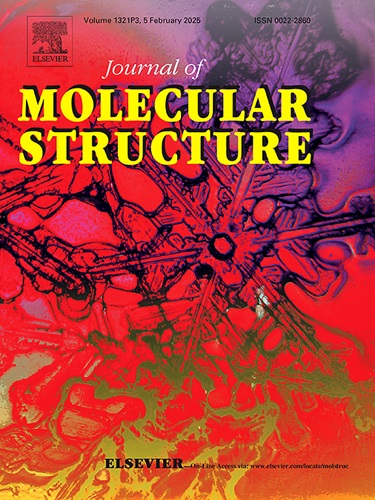Tm3+/ Dy3+共掺LiNa5(PO4)2荧光粉的光致发光研究
IF 4
2区 化学
Q2 CHEMISTRY, PHYSICAL
引用次数: 0
摘要
目前研究的主要领域之一是发光材料的生产。特别是,基于无机荧光粉的材料已广泛用于许多不同类型的应用,例如白光发光二极管(wled)、辐射剂量测定、场发射显示器(fed)、阴极射线管(crt)和灯具工业。在本研究中,我们利用固相反应方法成功合成了单主体LiNa5(PO4)2: Tm3+/Dy3+,实现了白光发射。在紫外光下分析了合成样品的发光性能。XRD分析证实了LiNa5(PO4)2的相纯度。SEM图像显示,荧光粉材料倾向于形成团块。LiNa5(PO4)2:Dy3+掺杂荧光粉的光致发光(PL)测量表明,在349 nm处激发有效,在487 nm(蓝色)和576 nm(黄色)处有明显的发射带。对于掺杂LiNa5(PO4)2: Tm3+的荧光粉,在458nm处观察到强烈的橙色发射,对应于Tm3+离子中的1D2→3H4跃迁。与这些稀土共掺杂会产生强烈的蓝色和黄色排放物。利用CIE颜色坐标计算了所制备的发光样品的颜色质量。因此,这些研究结果表明,Tm3+/Dy3+共掺杂的LiNa5(PO4)2荧光粉在UV led的激发下可以适用于制作白光发光二极管和显示器件。本文章由计算机程序翻译,如有差异,请以英文原文为准。

Photoluminescence investigation of Tm3+/ Dy3+ co-doped LiNa5(PO4)2 phosphors for color tunable LED applications
One of the main areas of research at the present time is the production of luminous materials. Particularly, materials based on inorganic phosphor have been widely used for many different kinds of applications, such as white light emitting diodes (WLEDs), radiation dosimetry, field emission displays (FEDs), cathode ray tubes (CRTs), and lamp industries. In this research, we successfully synthesized single-host LiNa5(PO4)2: Tm3+/Dy3+ by using the solid-state reaction method to achieve white light emission. The luminescence properties of the synthesized samples were analyzed under UV light. XRD analysis confirmed the phase purity of LiNa5(PO4)2. SEM images showed that the phosphor materials tend to form agglomerates. Photoluminescence (PL) measurements of LiNa5(PO4)2:Dy3+doped phosphors demonstrated efficient excitation at 349 nm, with prominent emission bands at 487 nm (blue) and 576 nm (yellow). For LiNa5(PO4)2: Tm3+ doped phosphors, strong orange emissions were observed at 458 nm corresponding to the 1D2→3H4 transitions in Tm3+ ions. Co-doping with these rare earths resulted in strong blue and yellow emissions. The color qualities of the luminous prepared samples were calculated using the CIE color coordinates. Therefore, these findings result suggest that Tm3+/Dy3+ co-doped LiNa5(PO4)2 phosphors, when excited by UV LEDs could be suitable for producing white light emitting diodes and display devices.
求助全文
通过发布文献求助,成功后即可免费获取论文全文。
去求助
来源期刊

Journal of Molecular Structure
化学-物理化学
CiteScore
7.10
自引率
15.80%
发文量
2384
审稿时长
45 days
期刊介绍:
The Journal of Molecular Structure is dedicated to the publication of full-length articles and review papers, providing important new structural information on all types of chemical species including:
• Stable and unstable molecules in all types of environments (vapour, molecular beam, liquid, solution, liquid crystal, solid state, matrix-isolated, surface-absorbed etc.)
• Chemical intermediates
• Molecules in excited states
• Biological molecules
• Polymers.
The methods used may include any combination of spectroscopic and non-spectroscopic techniques, for example:
• Infrared spectroscopy (mid, far, near)
• Raman spectroscopy and non-linear Raman methods (CARS, etc.)
• Electronic absorption spectroscopy
• Optical rotatory dispersion and circular dichroism
• Fluorescence and phosphorescence techniques
• Electron spectroscopies (PES, XPS), EXAFS, etc.
• Microwave spectroscopy
• Electron diffraction
• NMR and ESR spectroscopies
• Mössbauer spectroscopy
• X-ray crystallography
• Charge Density Analyses
• Computational Studies (supplementing experimental methods)
We encourage publications combining theoretical and experimental approaches. The structural insights gained by the studies should be correlated with the properties, activity and/ or reactivity of the molecule under investigation and the relevance of this molecule and its implications should be discussed.
 求助内容:
求助内容: 应助结果提醒方式:
应助结果提醒方式:


